
Lost for Words: Discovering Syria’s Contemporary Art Scene, in London
Jul 13, 2013 Exhibition
‘#WithoutWords – Emerging Syrian Artists’, draws together paintings, drawings and sculptures made in Syria then smuggled out of the country, or by Syrian artists living in exile. The exhibition is designed not only to raise awareness of contemporary Syrian artistic tradition, but also to provide funds for the humanitarian charity, Mosaic Syria.
‘Culture in Defiance – Continuing Traditions of Satire, Art and the Struggle for Freedom’, is an exhibition of Syrian street art and cartoons that was shown last year at the Prince Claus Fund Gallery in Amsterdam, and for six weeks at the Rundetaarn Gallery, in Copenhagen. The punchy drawings and cartoons are made and designed by sophisticated artistic collectives, often known by group names to hide the identity of their members. They have already aroused great interest amongst street artists in Europe, unaware that Syria has developed its own visual language to express the country’s struggle.
Both of these exhibitions coincide with the British capital’s summer celebration of Arab art and culture; the Shubbak Festival 2013. I spoke to Malu Halasa, a co-curator for both exhibitions and Tarek Tuma, who is an artist and curator for the ‘#WithoutWords’ exhibition, to find out more about contemporary Syrian artistic traditions and to explore the images that are so full of metaphors and hidden meanings.
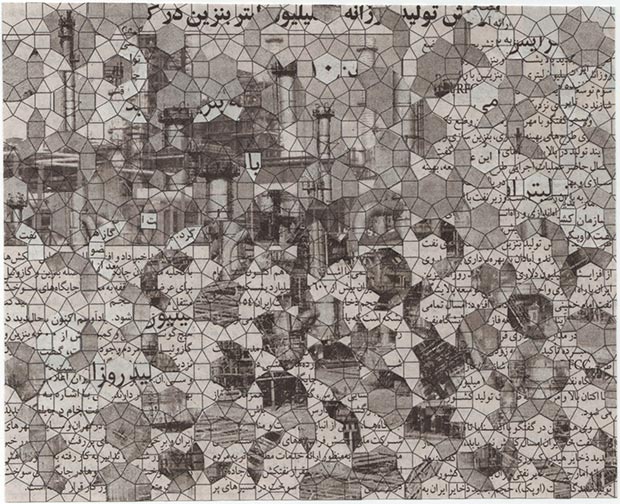 Nazgol Ansarinia, Reflections-Refractions, 2012 / Cortesy of the Artist
Nazgol Ansarinia, Reflections-Refractions, 2012 / Cortesy of the Artist
Despite their subject matter, many of the paintings in the ‘#WithoutWords’ exhibition, have a smooth, fine art quality. To someone unfamiliar with contemporary Syrian art, the perspectives and compositions of many of the works seem to evoke formal, perhaps old fashioned, art teaching. Malu Halasa explains, “While painting is not a traditionally Arab artform, Syria’s closeness to the Soviet Union and Russia, has meant that fine art is recognized an important tool for promoting socialist ideals and imagery in Syria. There are strong art faculties at the University of Damascus and art schools in Homs and Aleppo.†She says that art under the regime approached serious topics in a metaphorical way and though this has changed greatly since 2011, with artists expressing themselves more freely. “Since 2011, Syrian art has only changed in the sense that artists are able to express their feelings; their fears, their concerns, their defiance more overtly and more openly.â€
Many of the paintings and drawings in ‘#WithoutWords’, show the devastation and the brutality experienced by artists, such as: Ali Ferzat, Amjad Wardeh, Fadi Al-Jabour, Hamid Sulaiman, Hazar Bakbachi-Henriot, Jalal Maghout, Khaled Abulwahed, Lens Young Collective, Momtaz Shouaib, Philip Hourani, Ramez Bakir, Ronak Ahmed, Samer Saen Eldahr, Tarek Tuma and Zaria Zardasht.
Here, the curator’s role, is to give a voice or a narrative to the art that could be smuggled out of Syria – a difficult task. Tarek Tuma, admits, “The show was not easy to pull together at the start. We had artifacts in Syria, Lebanon, Jordan, Qatar, the UAE, Germany and France, which had to be brought to the UK... What unified the artists though, was their suffering and their expression of the suffering of the Syrian people. The show looks as fragmented as the destruction of our beloved country...â€
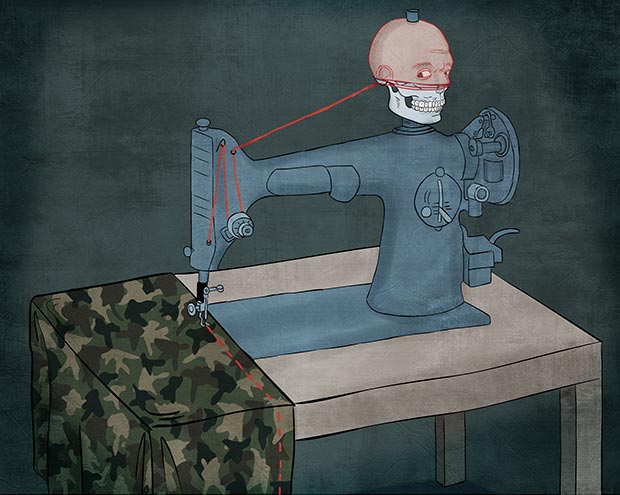 Sulafa Hijazi, Untitled, 2012, digital print, 80x100 cm / Cortesy of the Artist
Sulafa Hijazi, Untitled, 2012, digital print, 80x100 cm / Cortesy of the Artist
Malu Halasa also found the ‘#WithoutWords’ exhibition difficult to curate, but for different reasons, “I am used to feeling the power of photography and films, which is much more immediate. I needed time to understand these paintings and identify with their style and subject matter. I spoke to Tarek Tuma, and he showed me the anonymous line drawing ‘Faces of Syria’, that was done by an architects living in Hama, who saw the city destroyed and chose to draw a linear face – the lined face of Syria and its people. It is two dimensional, but also three four dimensional in what it stands for, what it replaces.â€
While some of the drawings, sculptures and paintings show the violence in the streets, the gunshots and anger felt by Syrian citizens, many portray the loneliness of war, the isolation, the confused emotions and feelings of betrayal or physical and mental pain felt by many of the artists. For them, art was a last resort; a place of release or freedom.
For painters such as Zaria Zardasht, “Each painting has its own secret that even the artist does not know. This secret gives a painting its privacy.†After the massacres of hundreds of Syrians in the north-western coastal town of Baniyas in early 2013, Zardasht painted 'Baniyas, The Wounded Spirit'. Her strong brushstrokes and abstract shapes reflect the blood, the bandages of the wounded, the emptiness, desolation and loss left behind after periods of panic, conflict and suffering.
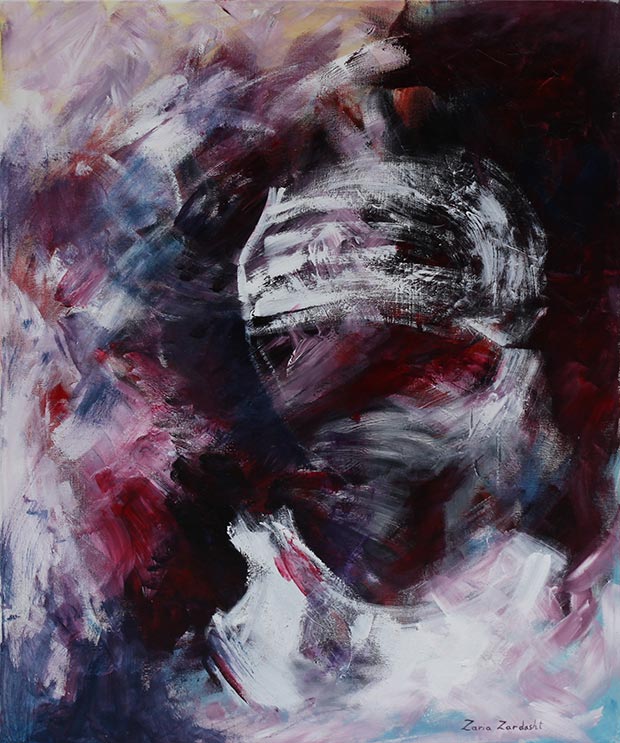 Zaria Zardasht, Baniyas, the Wounded Spirit, 2013, Acrylic on fabric, 70x50 cm / Courtesy of the Artist
Zaria Zardasht, Baniyas, the Wounded Spirit, 2013, Acrylic on fabric, 70x50 cm / Courtesy of the Artist
Another artist, Amjad Wardeh chooses to focus on the feelings of people around him, their grieving yet stoic facial expressions, in his series ‘Face to Face’. “.. Syrian people staring, waiting, missing their loved ones, feeling pain and [being] scared.â€
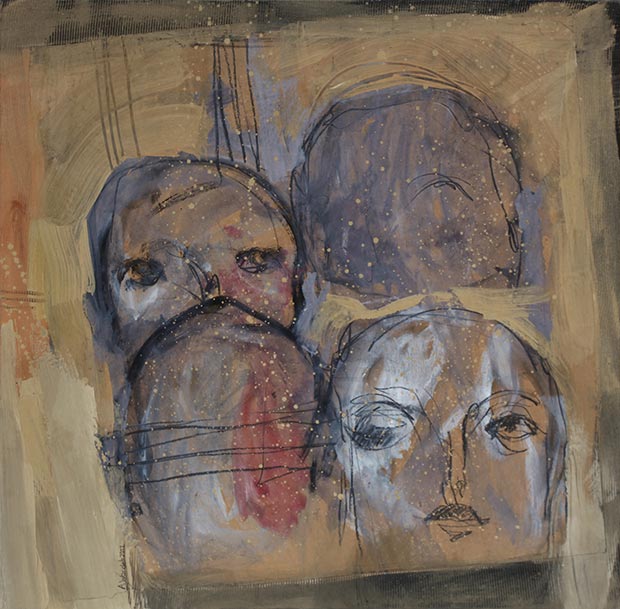 Amjad Wardeh, Backward Forward, from Face to Face series / Courtesy of the Artist
Amjad Wardeh, Backward Forward, from Face to Face series / Courtesy of the Artist
‘Homo Sacer’ is a Roman legal reference to a person who is both sacred and accursed - therefore distanced from society. It is a term chosen by Tarke Tuma for a series of works to show the different faces of physical and mental suffering; a wounded man with a gushing wound, for example and the smiling portrait of a Palestinan man, who expresses the continued suffering of the Palestinian people, timeless victim of wars, conflict and misunderstanding.
 Tarek Tuma, Hamza Bakkour, 2013, Oil on canvas, 205 x 175 cm, from the series Homo Sacer / Courtesy of the Artist
Tarek Tuma, Hamza Bakkour, 2013, Oil on canvas, 205 x 175 cm, from the series Homo Sacer / Courtesy of the Artist
“We tried to use the symmetry of the gallery [to hang the paintings] and then broke it as reflecting the conflict in Syria...†says Tuma. “You can see a broken symmetry everywhere implicitly - and explicitly in [many]... of the works…The aim of the show is not to shock, rather highlighting the tragedy in Syria in an aesthetic way. It is more like a poetic imagery which provokes feelings of sympathy, compassion and hope,†he smiles. “A hope that this humanitarian dilemma, or rather another test that humanity must solve.â€
“Each artist has his own explanation,†Halasa suggests. “Hamid Sulaiman’s bright colours [see Hunger Strike] reminded me of pop art, with their bright colours and shapes. [But then] I read the statement and realized that he was moved to paint after he had suffered torture and attended demonstrations. Another example is [Fadi Al Jabour’s] dolls from the powerful ‘Near Death’ series. They show beautiful dolls distorted or broken and stand for [the physical or emotional state of] the Syrian people who have suffered from a war that they didn’t choose.â€
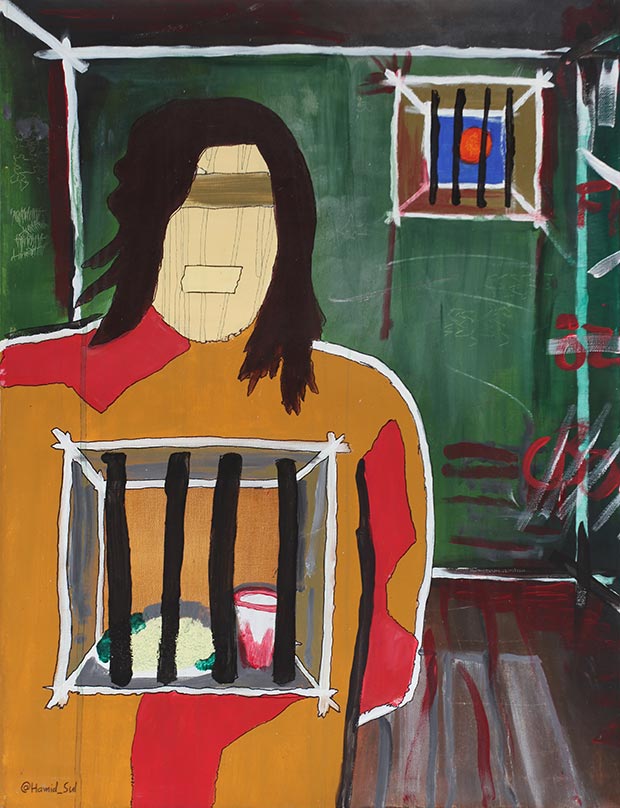 Hamid Sulaiman, Hunger Strike, 2012, Acrylic on canvas, 66x85 cm, from the triptych Hunger Strike, Speech Strike, Humanity Strike / Courtesy of the Artist
Hamid Sulaiman, Hunger Strike, 2012, Acrylic on canvas, 66x85 cm, from the triptych Hunger Strike, Speech Strike, Humanity Strike / Courtesy of the Artist
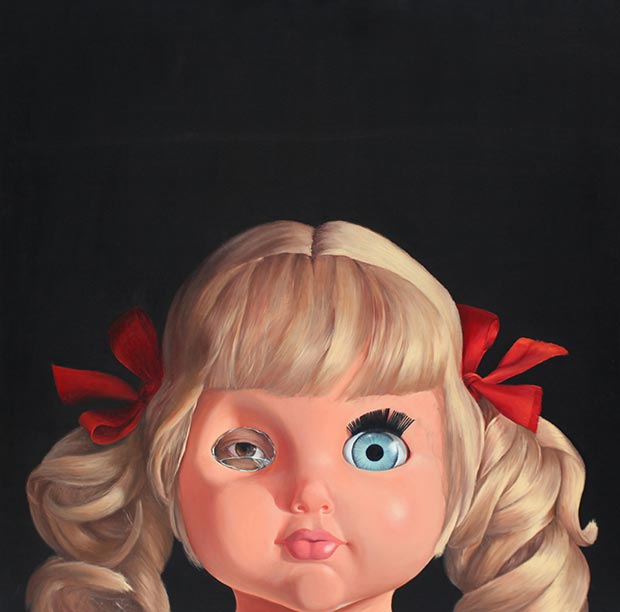 Fadi Al Jabour, Doll 1, 2011, Oil and acrylic on canvas, 120x120 cm, from the series Near Death / Courtesy of the Artist
Fadi Al Jabour, Doll 1, 2011, Oil and acrylic on canvas, 120x120 cm, from the series Near Death / Courtesy of the Artist
Tuma is optimistic, “In the end, this show shows the creative side of Syrians which people in UK do not see much... In the future, I hope this exposure will enable each individual artist to develop and progress. We hope also to bring more Syrian creative [people to] light [so that they can] … fight [and] struggle on the canvas to convert the fury into sensation.â€
‘Culture in Defiance’ is a week-long exhibition at RichMIx Gallery Café, in Shoreditch that features work by numerous named and unnamed Syrian artists and artistic collectives, cartoonists, filmmakers and calligraphers. Whereas the works shown in the ‘#WithoutWords’ exhibition reflect the artist’s struggle to make sense of the political situation, many of the drawings and posters in the ‘Culture in Defiance’ exhibition are more vocal. They are the result of individuals working together to promote awareness of the brutal regime, showing its actions against its own Syrian people and calling for its downfall. This is the first Syrian street art exhibition to be shown in the UK. The exhibition was originally put together for ‘The Prince Claus Fund’ in the Netherlands, that supports art and literature in countries where there is conflict. The exhibition was enlarged for exhibition in Copenhagen, Demnark by CKU, the Danish Center for Culture and Development. Malu Halasa also co-curated the exhibition, with Nawara Mahfoud and Aram Tahhan, when it was shown last year in the Netherlands.
In the ‘Culture in Defiance’ exhibition, she explains how the powerful, visual language of posters developed and tells me a little about groups such as ‘Alshaab alsori aref tarekh’ (‘The People of Syria [who] know the street’ in Arabic) an anonymous artist collective: “A fine artist in Damascus and a calligrapher in Homs were part of a team working on posters and visual images in Egypt and Tunisia for the Arab Spring. They turned to their own country of Syria when the revolution started and the team grew, incorporating more imagery and language. The team grew to maybe fifteen people, considering the image, tweaking the look and giving it more depth.†The resulting images have a strong presence, like advertising emblems or iconic comic strip characters.
Upon seeing the exhibition, a visitor may think of them whenever the Syrian conflict is discussed: 'Baba Amr' shows a masked youth shooting a catapult, one eye closed in concentration. Alshaab’s image of a figure - perhaps a woman - tying a scarf around her face resolutely bears the slogan: ‘I’m taking protest to the streets’. These stark black and white images are remarkably powerful and they show the determination that Syria’s women and its youth have, or must have, to resist persecution.
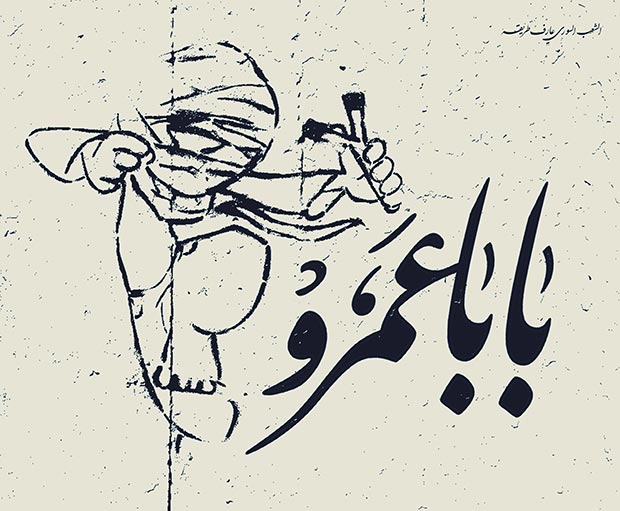 Alshaab Alsori Aref Tarek, Baba Amr, online poster / Courtesy of the Artist
Alshaab Alsori Aref Tarek, Baba Amr, online poster / Courtesy of the Artist
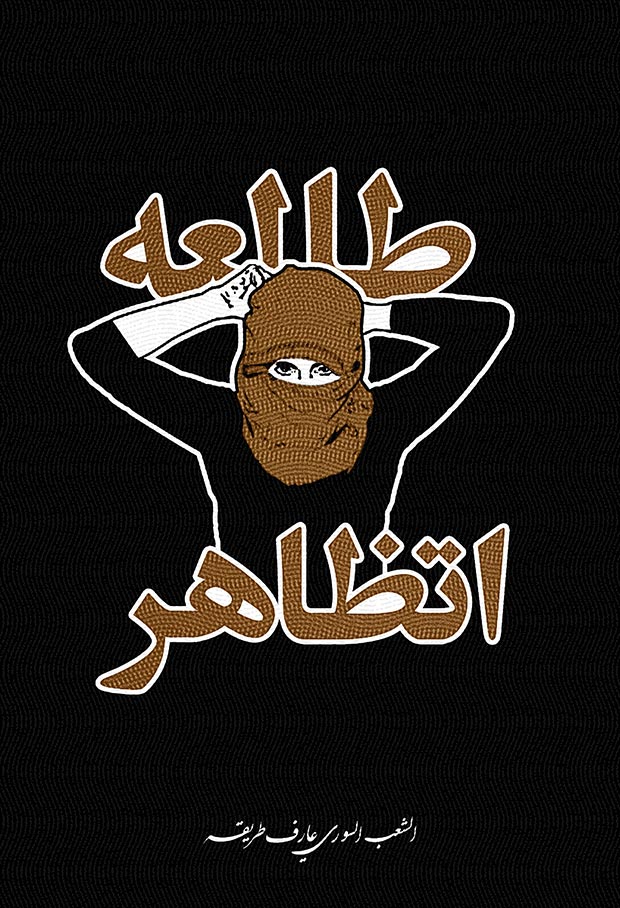 Alshaab Alsori Aref Tarek_Im taking to the streets to protest, online poster / Courtesy of the Artist
Alshaab Alsori Aref Tarek_Im taking to the streets to protest, online poster / Courtesy of the Artist
The posters, photographs, cartoons and short finger-puppet films, like the MasasitMati group’s ‘Top Goon – Diaries of a Little Dictator’ brings caricature, an important part of political street art, to the exhibition. Other strong, iconic images of women, skulls and tanks are portrayed in an expressive, linear language set off by angry, angular Arabic calligraphic slogans.
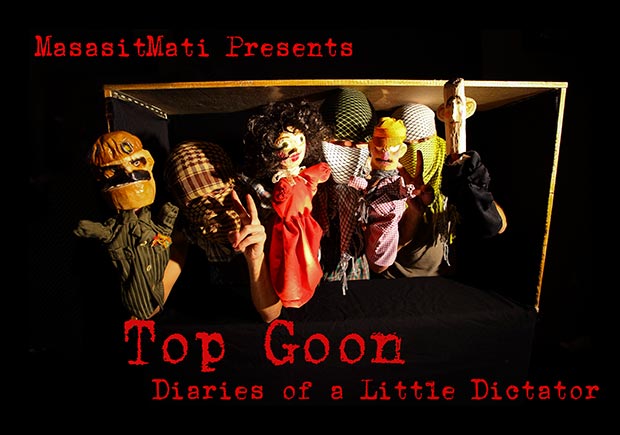 Masasit Mati, puppet cast of Top Goon, Diaries of a Little Dictator / Courtesy of the Artist
Masasit Mati, puppet cast of Top Goon, Diaries of a Little Dictator / Courtesy of the Artist
The exhibition is as much a testament to the power resulting from young people working together, as it is a testament to the dissident nature of street art and the ease with which graphic art and performance can carry both complex and startlingly direct messages. Revolutionary pop music plays, calling for the end of the regime ‘Yallah Erhal ya Bashar’ [‘Come on Bashar, Leave’] by Qashoush and the misunderstanding of political events is eloquently expressed in Shadi Ali’s ‘Kirmal yali raho’ (‘For the people who went away’) and Nos Tofaha’s ‘Lish Darb Al Nar?’ (‘Why are you shooting us?’).
Both ‘#WithoutWords’ and ‘Culture in Defiance’ exhibitions express, very differently, the tragedy felt by the Syrian people. The anger, violence and despair that is expressed is so brutal and real, that one is left, as the exhibition title suggests: Without Words.
Both exhibitions offer hope, not only for the suffering though defiant people of Syria, but also for a new and inspiring moment in Syrian contemporary art. ‘#WithoutWords’ exhibition is at the P21 Gallery in London until 1 September 2013. ‘Culture in Defiance’ will show at RichMix Gallery in Bethnal Green, London E1, until 13 July 2013.
Comments
Add a comment